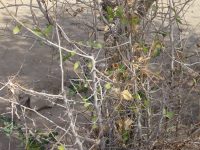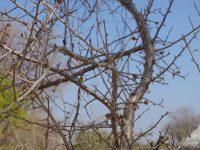|
IUCN Red List Status: Critically Endangered (CR)
. Commiphora wightii (Arn.) Bhandari, Bull. Bot. Surv. India 6: 327 1964. (syn: Balsamea mukul Baill.; Balsamodendrum mukul Hook. ex Stocks; Balsamodendrum wightii Arn.; Balsamodendrum roxburghii Stocks; Commiphora mukul (Hook. ex Stocks) Engl.; Commiphora roxburghii Engl.); .
India – Gujarat, – Karnataka, – Madhya Pradesh, – Rajasthan; Pakistan – Sind (as per NPGS)
. India (Rajasthan, Gujarat, Madhya Pradesh, Karnataka), Pakistan (Baluchistan, Karachi, Sind, Baluchistan, Pakistani Punjab), Oman (Dhofar) as per Catalogue of Life;
.
Commiphora wightii, with common names Indian bdellium-tree,[2] gugal,[3] guggul,[2] gugul,[2] or Mukul myrrh tree, is a flowering plant in the family Burseraceae. The guggul plant may be found from northern Africa to central Asia, but is most common in northern India. It prefers arid and semi-arid climates and is tolerant of poor soil.
It is a shrub or small tree, reaching a maximum height of 4 m (13 ft), with thin papery bark.[3] The branches are thorny. The leaves are simple or trifoliate, the leaflets ovate, 1–5 cm (0.39–1.97 in) long, 0.5–2.5 cm (0.20–0.98 in) broad, and irregularly toothed. It is gynodioecious, with some plants bearing bisexual and male flowers, and others with female flowers. The individual flowers are red to pink, with four small petals. The small round fruit are red when ripe.
C. wightii is sought for its gummy resin, which is harvested from the plant’s bark through the process of tapping. In India and Pakistan, guggul is cultivated commercially. The resin of C. wightii, known as gum guggulu, has a fragrance similar to that of myrrh and is commonly used in incense and perfumes. It is the same product that was known in Hebrew, ancient Greek and Latin sources as bdellium.
The gum can be purchased in a loosely packed form called dhoop, an incense from India, which is burned over hot coals. This produces a fragrant, dense smoke. The burning coals which let out the smoke are then carried around to different rooms and held in all corners for a few seconds. This is said to drive away evil spirits as well as remove the evil eye from the home and its family members.[citation needed]
C. wightii has been a key component in ancient Indian Ayurvedic system of medicine. However, because of its overuse, it has become so scarce in its two habitats in India — Gujarat and Rajasthan – that the World Conservation Union (IUCN) has enlisted it in its Red Data List of endangered species.
The extract of gum guggul, called gugulipid, guggulipid, or guglipid, has been used in Unani and Ayurvedic medicine, for nearly 3,000 years in India.[4] One chemical ingredient in the extract is the steroid guggulsterone,[5] which acts as an antagonist of the farnesoid X receptor, once believed to result in decreased cholesterol synthesis in the liver. However, several studies have been published that indicate no overall reduction in total cholesterol occurs using various dosages of guggulsterone and levels of low-density lipoprotein (“bad cholesterol”) increased in many people.[6][7]
(from Wikipedia on 30.12.15) . The wild occurrence of this species is limited mainly to the dry regions of Rajasthan and Gujrat States of India and the adjoining regions of Pakistan. Oleo-gum resin tapped from the stems of this species constitutes the well known Ayurvedic drug “Guggul” which is consumed in high volumes by the Indian herbal industries. Field observations over the last several decades have confirmed a severe decline in its wild population, as the shrubs tapped for oleo-gum resin die within two to three years. Over the past 84 years (three generation lengths) there has been a decline of more than 80% in the wild population as a result of habitat loss and degradation, coupled with unregulated harvesting and tapping of oleo-gum resin. This species is therefore assessed as Critically Endangered.
. Images of Commifera wightii from Nashik : 1 post by 1 author. Attachments (5)
attaching images of Commifera wightii from Nashik, i thank … for correcting my previous post on C wightii
ID request 180516SG : 4 posts by 3 authors. Attachments (3)
Requesting ID of this woody plant, about 4-5’ high with new flushes and a fruits of previous one. Photo taken on 18May16 at Solapur, Maharashtra Commiphora wightii (Arn.) Bhandari [Burseraceae]. Commifera wightti : 1 post by 1 author.
………….. later on i was able to sight Commifera wightti in wild, attaching images
Wild Shrub for ID : Muscat,Oman : 160113 : AK-1: Some Burseraceae member. Thanks for a possible id.
It was very breezy when the pictures were taken, will try taking better ones next time.
Also, I seem to have missed the flowering season.   request for id: 2 high res. images. Is this commiphora berryi?
Location Dholavira, Rann of Kutch
December 2024
I think it is
https://efloraofindia.com/efi/commiphora-wightii/ |
Commiphora wightii
Updated on June 3, 2025
